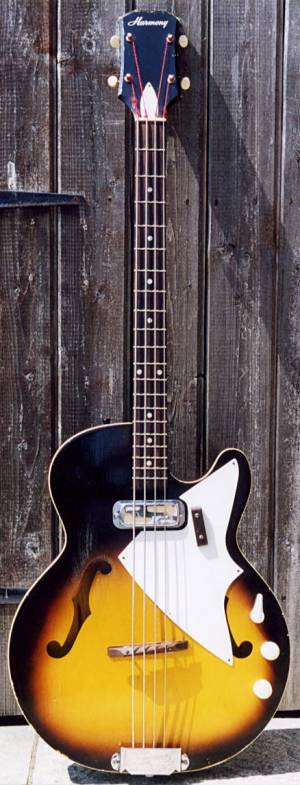
Ronnie "Plonk" Lane visited the J60 Music Bar guitar store in Manor Park, East London early in 1965, shopping for a bass. The Saturday assistant there was a fellow named Steve Marriott, former leader of The Moments, who sold Ronnie a Harmony H22. The pair became friendly, the seeds of the Small Faces were sown, and one of the great British song-writing partnerships of the sixties was born. Reason enough, surely, to check out this wonderful bass!
Hollow-bodied bass guitars often leave much to be desired in performance, the acoustic chamber contributing all of the "wrong" stuff to the sound by removing much of the punch and attack and replacing it with a muddy rumble. This characterised the sound of many beat groups of the sixties, in the days before state-of-the-art PA systems and stage monitoring, when the bass had to glue the drums to the floor for maximum dance potential. Players of the day liked them because they were light in weight, and a lot cheaper than a Fender - McCartney's Hofner Violin and Bill Wyman's Framus Star Bass were entry-level instruments aimed at the budget-conscious musician. As indeed was Harmony's H22, a bass version of their popular Rocket series (stay tuned!), equipped with a single Rowe DeArmond pickup, a tone switch, adjustable rosewood bridge and a natty pick-guard, presumably drawn up by the guy who invented the Stealth bomberů
Though cheap and cheerful, this bass has all the high-quality attributes typical of Harmony. One-piece maple neck with rosewood fingerboard, flat top and back both with one-piece maple veneer, carved rosewood finger-rest and bridge, and that fabulously punchy pickup. Though located near the neck for best bass frequency response, it nonetheless has plenty of attack that knocks seven shades out of Gibson's costly EB-2. The 2-position tone switch, operated by what looks like a toilet flush-handle, is basically a low-pass filter that offers a little more top end while effectively reducing the output. Very cheerful!
And the cheap stuff? The tuning machines, two-on-a-plate style with open-backed gears that look quite cute on the large, paddle-shaped head stock but are not very practical. The bolt-on neck still has its original frets, and this is the area that usually betrays Harmony's quality control. Often poorly-finished and uneven, there are always one or two that give problems though on this instrument, only one of the higher ones needs attention and they're better than average.
When I took delivery of it, I discovered the wooden string anchor was not properly aligned with the neck, the G string virtually hanging off the edge of the fingerboard - how frustrating that must have been for 3 generations of previous owners! I drilled two new holes ╝" to the left and re-seated it under the chrome cover, and now it's hunky-dory.
Whenever I strap this bass on, I just can't put it down! It sounds fantastic through my '62 Fender Tremolux amp, and with its flat-wound strings it's a perfect blend of electric and upright. It records quite well, though there are a few flat spots here and there and I've had a few tuning problems with it. Not that I care - I'm a bass-playin' fool in love.